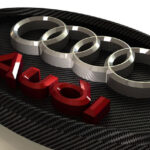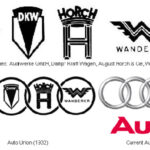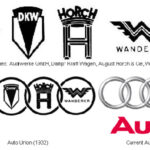An intriguing story…
In Germany during the late 19th and early 20th centuries, there was a popular legend about an anonymous baker from Munich who unexpectedly became the chief designer for most car companies. Initially, he divided a cake into three equal parts and sent them to Mercedes to create their logo. Another cake was divided into four equal parts for BMW. However, when it came to Volkswagen’s turn, the baker was perplexed and drew a few random lines, which formed two V letters. Although not entirely satisfied, Volkswagen still accepted it.
.jpg)
When the four owners of Audi approached the baker to design a logo for their collaboration, he was truly puzzled. He had no idea what to do with the small cake anymore. However, while serving the guests, he had an epiphany when the fourth cake was placed on the plate. He decided to represent the four companies that founded Audi by using four cakes. In order to avoid disappointing any of the distinguished guests, he arranged the cakes horizontally, even though it took up more space. When the plate with this conceptual logo was presented on the table, the four owners looked at each other and… smiled.
This is just a whimsical tale that car enthusiasts came up with to explain the fortuitous encounter in the logo design of German car brands, including Audi.
…Symbolizing unity
Car enthusiasts crafted a story about the four cakes of the baker, and although it is a fun explanation, it is rooted in history. In reality, the four circles in the Audi logo represent the combination of car brands AUDI, DKW, WANDERER, and HORCH.
.jpg)
Audi was founded in 1899 by August Horch, a German automobile manufacturer. August Horch was one of the pioneers during the early days of the German automotive industry. He initially worked at the Carl Benz factory, which was responsible for producing Mercedes-Benz cars, and quickly ascended to become the director of the engine manufacturing department. Due to his talent and assertive personality, he encountered disagreements with the management board and ultimately left the Carl Benz factory to establish his own brand. In 1899, he founded the company Horch & Cie in Cologne.
The first Horch car rolled off the production line in 1901 in Zwickau. In 1910, Horch was expelled from the company he had founded. Undeterred, he started a new company and continued manufacturing cars under the Horch brand. The old company sued him for trademark infringement, and a German court ruled in favor of the old company, stating that the Horch trademark belonged to them. Consequently, August Horch was no longer able to use his family name for the cars produced by his new company. Since the word “horch” means “listen” in German, August Horch opted for a Latin word with the same meaning to name his new venture: Audi. Many people believe that Audi is an abbreviation for “Auto Union Deutschland Ingolstadt.”
.jpg)
In 1932, Audi joined forces with Horch, DKW, and Wanderer to establish Auto Union. At that time, Auto Union AG ranked as the second-largest company in the world. It was also in 1932 that Auto Union unveiled the symbol of four interconnected circles, representing the four companies. The circles, all of equal size and placed horizontally, symbolize unity and mutual respect.
Over 80 years of iconic branding
Following World War II, Auto Union’s factories were located in East Germany. Most of the company’s leaders relocated to Bavaria, where BMW was headquartered. It was here that they founded Auto Union GmbH in 1949. Auto Union GmbH continued the tradition of producing cars, and the intertwined four circles remained the official logo of the company.
.jpg)
In 1969, Auto Union GmbH merged with NSU to form Audi NSU Auto Union AG. However, due to the name’s length and inconvenience for business purposes, the company changed its name to Audi AG in 1985. Despite the addition of a fifth company to form the “Audi” we know today, the company continues to use the four-circle logo, which had already become familiar to consumers during its 53-year existence.
Upon their first glance at the Audi logo, many people mistakenly associate it with the Olympic Games symbol. The Olympic flag features five circles, which were introduced in 1914 by Count Pierre de Coubertin, the first president of the International Olympic Committee. They became the official symbol of the 1920 Olympic Games in Antwerp, Belgium, representing the five continents united in the Olympic movement.
.jpg)
Audi’s four concentric circles have now stood for over 80 years, just like the brand itself, which approaches the century mark. It is highly likely that the logo designer for Audi drew inspiration from the meaning and artistic form of the Olympic symbol. Throughout its history, facing both triumphs and tribulations, Audi has maintained its position as one of the foremost luxury car brands, thanks to its commitment to producing high-quality products that stand out from the competition.
Thu Ha (TTTD)









































